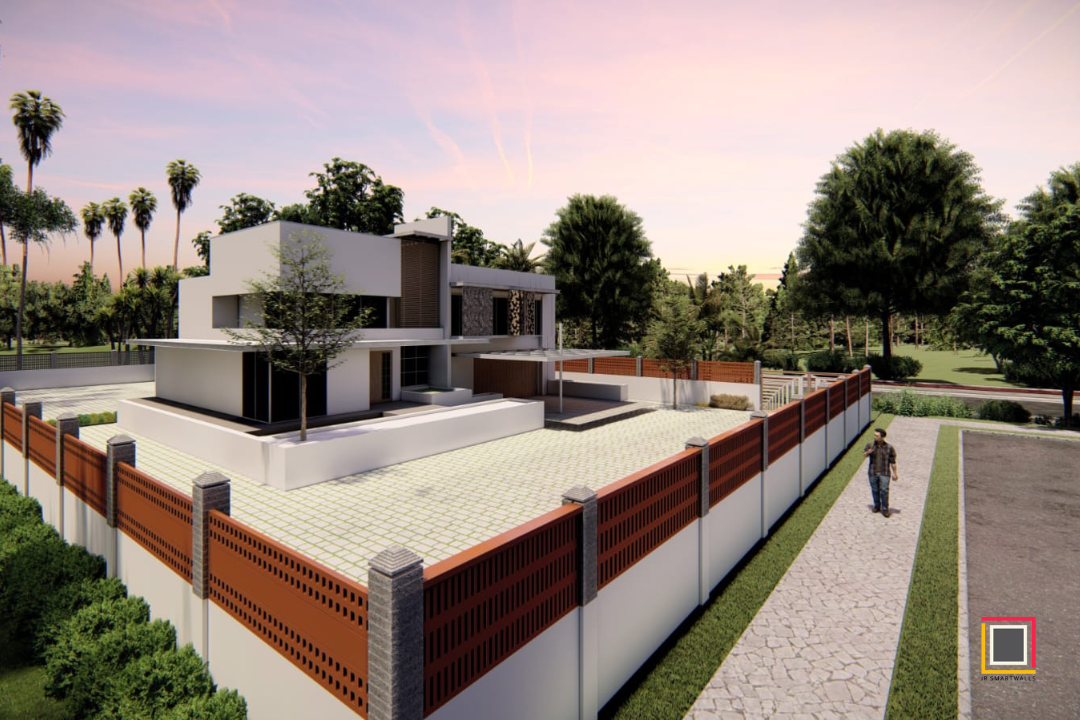What are precast concrete walls?
Precast boundary or precast concrete walls are made by casting in moulds offsite, allowing them to be precast in controlled conditions before being installed on-site. Precast concrete walls are mainly used to define property boundaries and provide security, safety, and privacy with attractive custom designs. These are used in residential, commercial, or industrial properties. Precast concrete boundary walls are fire, termite, and weather-resistant and three times more durable than traditional compound walls.
In the installation process, these panels precast in concrete are set and bonded using various methods such as interlocking mechanisms, bolts, or adhesives. They may also feature particular features like patterns, textures, or finishes used during casting to improve their appearance. Concrete boundary wall precast provides numerous advantages, including quicker installation than traditional casting, consistency in quality thanks to the control of manufacturing processes, longevity, and lower requirements for labour. They are durable barriers, offering privacy and security while needing minimum maintenance throughout their lives.

Advantages of precast concrete walls
Concrete precast walls have a variety of advantages over conventional or alternative wall construction techniques. These advantages include:
Durability: Concrete compound wall precasts are known for their incredible endurance, ensuring long-term durability under various environmental conditions. The walls are made of top-quality concrete and reinforced by steel, creating sturdy structures that can withstand time. In addition, the precast concrete compound walls are highly resistant to physical assaults, providing solid security and protection while keeping their strength and structural quality. It makes them durable and will last for a longer life span, with little maintenance throughout the years, which makes them a durable and long-lasting choice for your boundary security and property borders requirements.
Ease of Installation: Precast concrete walls are relatively straightforward and require less on-site labour than traditional construction methods. Once delivered, these elements can be erected efficiently using specialized equipment, reducing installation time.
Precast concrete walls are versatile and can be utilized in many different applications, such as industrial, commercial, residential, and infrastructure projects. They can be used as walls for boundary walls, retaining or noise barriers, and decorative elements, among many other purposes.
Weather Resistant Concrete walls made of precast are resistant to various weather conditions, such as extreme temperatures, wind, and moisture. This protection helps preserve the walls’ structural stability and aesthetics over time.
Easy Maintenance Once installed, the precast concrete walls will require little maintenance throughout their life. They are less susceptible to cracking, deterioration, or degrading when compared with other building materials, thus reducing the requirement for frequent repairs.
Precast Concrete is Fire Resistant: It naturally has fireproof properties. The composition of the concrete makes it highly resistant to fire, offering additional security for buildings where fire safety is essential.
Speed of Construction: Since precast elements are manufactured off-site, they can be produced simultaneously with on-site preparation work. Once transported to the construction site, installation is relatively quick compared to traditional methods, speeding up the project timeline.
Cost-effective: precast compound walls are more cost-effective than traditional compound walls or other methods. The speedy and time-saving installation process with minimum labour helps the precast compound walls become more cost-effective.
These numerous advantages collectively demonstrate why precast concrete walls continue to be a popular choice in the construction industry, offering a wide array of benefits throughout the entire lifecycle of a building or infrastructure project.

Difference between precast and traditional compound walls
Construction Process:
Precast Compound Walls: These walls are manufactured offsite in controlled environments. Concrete is poured into rubber moulds to create standardized panels or sections and then transported to the construction site for installation. It can quickly finish the work with custom designs.
Traditional Compound Walls: Traditional walls are built on-site using bricks, stones, or concrete blocks. Construction involves laying these materials layer by layer, often requiring skilled labour for bricklaying or blockwork. The process includes preparing the foundation, mixing mortar, and the wall’s sequential construction. It may take more time to finish the work.
Quality and Consistency:
Precast wall panels provide the same quality because they are produced under controlled conditions. They ensure consistency in strength, size and quality across the entire wall.
Classic Compound Walls: The standard of traditional wall constructions can differ depending on the expertise of labourers, the quality of the materials used, and construction techniques that could lead to variations in strength, appearance, and endurance.
Speed and Efficiency:
Precast Compound Walls: the compound walls are precast for faster installation than regular compound walls. So, precast compound walls’ structure is quicker than traditional compound walls.
Traditional Compound Walls: Traditional walls are a time-consuming process due to the sequential laying of materials, and the need for skilled labour for each construction will consume more time than the precast compound walls.
Design and Customization:
Precast Compound Walls: it is easy to make custom or attractive designs in precast compound walls while manufacturing. It offers different types of design flexibility with options for various textures, finishes, and panel shapes during the manufacturing process, allowing for customization to meet specific aesthetic or functional requirements.
Traditional Compound Walls: It is not easy, and it may take longer to make a custom and attractive compound wall design with a formal compound wall process.
Durability and Maintenance:
Precast Compound Walls: precast compound walls are more famous for their durability and strength. They only require minimal maintenance over their lifespan. Precast compound walls are fire, termite and weather-resistant.
Traditional Compound Walls: The durability of traditional walls is based on the quality of materials used and construction practices. They might require more frequent Maintenance and repairs due to potential issues like cracks, erosion, or moisture damage.
FAQ
Why should you choose to build compound walls over ordinary walls?
The compound walls offer many benefits over regular barriers, such as low maintenance costs and easy installation across an ample space, high quality and long durable life span, appealing design, and quick duration. Compared to standard walls, boundary walls can be profit-making as high as 60%.
What makes JR smart walls unique?
JR smart walls differ from other walls because the moulds of rubber that are used for the production of JR smart walls are cast only to be used for boundary wall precast designs, which provide a good finish with a firm, attractive and durable design. The moulds that we use are high-quality because the rubber that is used to create the rubber moulds used for compound wall precast is sourced from our native in Kerala, India. Unique designs, as well as the specially cast rubber moulds, make JR smart walls different in comparison to other walls.
Advantages of precast compound walls
- Customized design with aesthetic appeal
- Three times more durable than the conventional method
- Strength – made with M30 concrete, AR fiberglass
- Finish – unmatched finishing with rubber moulds, better finishing than handwork
- Dimensional stability – as it is cast with moulds
- Consistent quality
- Time-saving installation
- Less space consuming
- Reduced maintenance
- Versatility of applications
- Fire, termite, weather resistant
What is the purpose of precast compound walls?
The precast compound walls block traffic and block out strangers through our personal space. The privacy and security of our daily lives are more than just a matter of walls aiding us. Precast compound walls help bring it to life in a very short period and at a cost-effective price.
How are precast compound walls made?
Precast concrete that has been poured into a reusable JR-made rubber mold that can be specially cast to make wall precasting; after it has completed the filling of concrete, the mould will be put in the vibrating table to vibrate, which assists in removing air bubbles that are present in the concrete. Precast compound walls have an excellent finish.
What makes concrete walls the best in the world of compound walls?
Concrete stands strong and tall when considering other compound wall materials. The unmatched durability, versatility, and affordability make house owners, contractors, and builders choose concrete walls. Concrete boundary walls are fire, termite, and weather-resistant; precast compound walls will last longer than traditional ones. Concrete boundary walls are cost-effective, time-saving installation, easy to make custom designs, sturdy and durable, unmatched finishing than the hand made boundary walls. These features of concrete boundary walls make them more popular in the field of compound walls.


